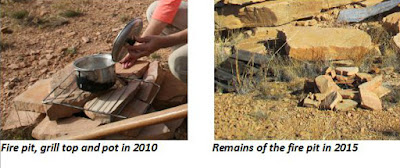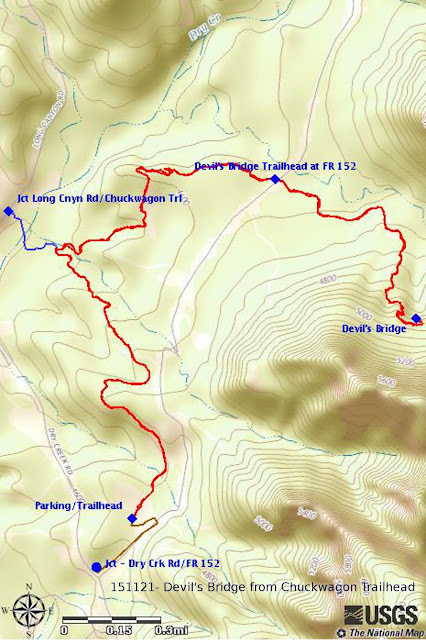Because
of the many connecting trails in the area, the Diving Board hike
requires some attention to detail. George Everman and I first
scouted the hike last October and determined the best sequence of
trails to use for this scheduled 19 December 2015 hike.
The
trail, as hiked, starts at Yavapai View parking area which is
located on the west side of Hwy 179 northwest of Bell Rock. To reach
the parking lot, from the Village of Oak Creek, we drove north on
Hwy 179 to Sedona. At the first roundabout in Sedona, at Indian
Cliffs Road, we made a 180 degree turn, and returned south on Hwy 179
for about 1.6 miles to the entrance to the parking area. This
parking area is located on a counterclockwise circle with parking
spaces positioned along the outside perimeter on the southeast side.
The
below group photograph was taken at the parking area after the hike
was completed.
Nineteen
of a total of 22 hikers are identified in the above photograph. Jim
Wagner, having a prior commitment to attend another event, had left
the hike early while the rest of us were still eating lunch at the
Diving Board.
From
our cars, we walked clockwise around the parking circle, passing a
toilet and a kiosk to reach the Yavapai Vista Trailhead (below
left). We didn't actually hike on Yavapai Vista
Trail, just walked to the sign and then turned sharply left onto a
short connector trail (below
right) that led us across a wash to Coconino Trail
about 75 yards ahead.
We
turned south on Coconino Trail (below left)
and followed it for 0.3 miles until it ended at Slim Shady Trail
(below right), passing Basalt
Trailhead along the way.
We
turned left on Slim Shady Trail and followed it for 0.3 miles to the
junction with Made in the Shade Trail (below
left). From this point, it is another 1.7 miles to
the Diving Board. It is not clear just how much of this distance is
actually traveled on Made in the Shade Trail. I have an old Arizona
topographic map which indicates that our GPS track to the Diving
Board departed from Made in the Shade Trail after 1.1 miles. The
same map shows Made in the Shade Trail continuing southeast from
there to connect with Canyon Ridge Circle in the Village of Oak
Creek. On this old map, the last 0.6 miles of the trail we followed
to the Diving Board is not shown at all. The trail (below
right) became less distinct as we approached our goal.
In a few places, as we crossed bare rock, it was not visible at all
and we had to search for signs of a trail leaving the rock on the
other side.
Eventually
we turned sharply up the mountain, climbing about 350 feet in 0.3
miles. The slope up which we were hiking can best be viewed in the
following photograph, taken from farther down the trail. In that
photograph, the Diving Board is actually the flat top of the left
shoulder jutting out from the butte shown in the photograph; the top
is actually shaped roughly like a diving board.
About
1.5 miles from the Slim Shady/Made in the Shade Trail junction, the
trail forks, one branch going straight ahead to a gap in the mountain
(upper right in the below photograph) while the other turns sharply
left and follows closely along the slope to the Diving Board.
We
paused at the fork to decide whether we should continue on to the
gap, only about 100 yards, to see what was on the other side,
eventually deciding to do so on our way back.
 |
The Diving Board as seen from the trail
|
The
0.2 miles section of trail on to the diving board ran first along the
slope and then close along the cliff wall with little room to spare
(below left). A small diving
board-shaped formation appears at the corner of the cliff (below
right), but it was not what we were looking for.
Rounding
the corner we have our first close up view of the Diving Board we
sought.
 |
| First view of the Diving Board |
By
walking out to the end of the formation we could look almost straight
down on the Village of Oak Creek.
 |
Looking down on the Village of Oak Creek from the Diving Board
|
We
were rewarded by panoramic views from Bell Rock to House Mountain.
The view below, looking across Hwy 179, shows Bell Rock and
Courthouse Butte backed by Lee Mountain and Munds Mountain in the
distance. In the lower right corner can be seen a small slice of the
Village of Oak Creek.
 |
Bell Rock, Courthouse Butte and a bit of the Village of Oak Creek
|
On the way back we
paused at the gap for the following view. The outcropping at left is
the backside of the butte above the Diving Board. Barely visible at
the right is the cliff wall of the mountain range which contains
Cathedral Rock. We did not determine for sure whether the trail
continues beyond the gap to connect with Cathedral Trail at some
point. We think that it does.
 |
Jim Manning is shown viewing the Village of Oak Creek through the gap
|
The total hike
according to my GPS was 4.8 miles including the short added hike to
the gap. The highest elevation was 4616 feet and the total ascent
was 656 Feet.
Our GPS track to the
Diving Board is shown in red on the included map; the short blue line
is the added track to the gap.












































